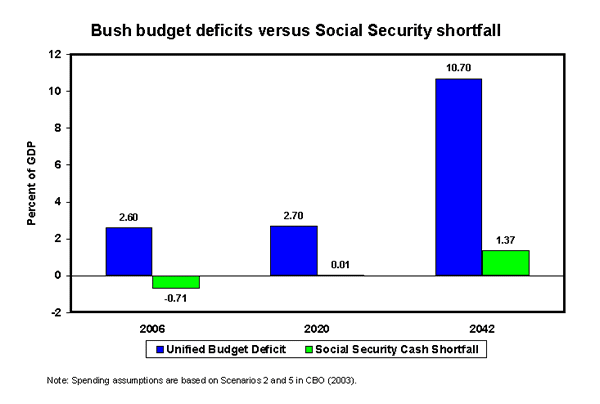See Snapshots Archive.
Snapshot for March 23, 2005.
Big deficit, little deficit: The Bush budget and Social Security
Today the Trustees of Social Security issued their annual report on the state of the program’s finances. Much attention was devoted to years 2017 and 2041, when, respectively, the program is said to begin running cash shortfalls and the Trust Fund assets are exhausted. Social Security finances in these years ought to be considered in the context of the federal budget as a whole. The results are dramatically different, depending on whether tax cuts enacted since 2000 are allowed to remain in place.
The figure below compares projected deficits in the federal budget under Bush Administration policies with Social Security cash shortfalls. All data are from reports of the Congressional Budget Office (CBO).

The left-hand bars in each pair show unified budget deficits for 2006, 2020, and 2042. The 2006 forecast is from the most recent March CBO report on President Bush’s Fiscal Year 2006 budget proposal. The estimated deficit of 2.6% of GDP is conservative, and it does not include all likely military spending or the costs of borrowing to fund the president’s proposal for private retirement accounts. Even so, deficits of 2.6% of GDP are unsustainable in the long run.
Deficits will remain at roughly that level through 2020. This projection assumes the Bush tax cuts are extended, and that Medicare and Medicaid spending increases at a moderate pace.*
The unsustainability of the Bush tax cuts is reflected in the third bar, which indicates deficit levels in 2042. Under current policies, the deficit will balloon to over 10% of GDP.
These federal budget deficits put the Social Security cash shortfalls, shown in the right-hand bar of each pair, into proper perspective. This year, the program is running a cash surplus of 0.71% of GDP. By 2020 it will run a very small cash deficit of 0.01% of GDP. By 2042 this shortfall will increase to 1.37% of GDP, but will be dwarfed at that point by the overall budget deficit.
By contrast, the CBO projections show that if the Bush tax cuts are allowed to expire after 2010, federal taxes will gradually rise to 24.7% of GDP over the subsequent 40 years.** Under the same scenario for program spending as shown in the figure, the result is an overall federal budget surplus for every year after 2010, through 2050. Allowing the Bush tax cuts to expire would eliminate budget deficits for the foreseeable future, allowing full payment of scheduled Social Security benefits and expected growth in spending for Medicare and Medicaid.
* Spending assumptions are based on Scenarios 2 and 5 in CBO (2003).
** Revenue assumptions are based on Scenario 5.
References:
Congressional Budget Office. The Long-Term Budget Outlook. Washington, D.C., December 2003.
Congressional Budget Office. An Analysis of the President’s Budgetary Proposals for Fiscal Year 2006. Washington, D.C., March 2005.
Sawicky, Max B. Collision Course: The Bush Budget and Social Security, Economic Policy Institute, March 2005.
This Snapshot was written by EPI economist Max B. Sawicky.
